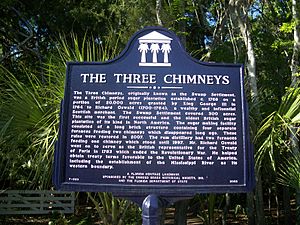Three Chimneys Archaeological Site facts for kids
The Three Chimneys Archaeological Site is a special historical place located in Ormond Beach, Florida. You can find it at 715 West Granada Boulevard. This site was added to the National Register of Historic Places on September 16, 2010. The name "Three Chimneys" comes from the three tall chimneys that were once part of a sugar-processing plant here long ago.
Archaeologists have carefully dug up parts of this site. They have learned a lot about what life was like when the sugar plant was active.
Contents
What is the Three Chimneys Site?
The Three Chimneys Archaeological Site is a place where people can learn about the past. It shows us how sugar was made hundreds of years ago. The site is named after the three large chimneys that stood there. These chimneys were part of a building where sugar cane was turned into sugar.
Why is it an Archaeological Site?
An archaeological site is a place where people find clues about the past. These clues are often buried underground. Archaeologists are like detectives who dig up and study these clues. They learn about how people lived, what they ate, and what tools they used. At the Three Chimneys site, archaeologists found parts of the old sugar plant. They also found other items that tell us about the people who worked there.
The National Register of Historic Places
The National Register of Historic Places is an official list in the United States. It includes buildings, sites, and objects that are important to history. When a place is on this list, it means it is special and worth protecting. The Three Chimneys site was added to this list because it helps us understand Florida's history. It shows us how important sugar production was in the past.
Sugar Production in Early Florida
Sugar cane was a very important crop in Florida many years ago. People grew sugar cane to make sugar, molasses, and rum. These products were valuable and traded widely. The Three Chimneys site was one of the places where this happened.
How a Sugar Plant Worked
A sugar-processing plant like the one at Three Chimneys had several parts. First, sugar cane was harvested from fields. Then, it was brought to the plant. The cane was crushed to squeeze out its sweet juice. This juice was then boiled in large kettles. The chimneys helped to create the heat needed for boiling. As the water evaporated, the sugar would crystallize. This raw sugar was then prepared for shipping or further refining.
The Role of the Chimneys
The three chimneys were a key part of the sugar-making process. They were connected to furnaces that heated the kettles. The chimneys helped to draw smoke and hot air away. This kept the fires burning strongly and safely. They were tall and strong structures, which is why parts of them still remain today.
What Archaeologists Discovered
When archaeologists excavated the Three Chimneys site, they found many interesting things. They uncovered the foundations of buildings. They also found parts of the machinery used to process sugar. These discoveries help us understand the layout of the plant. They also show us the methods used for making sugar long ago.
Clues from the Past
Besides the plant structures, archaeologists found other artifacts. These included pieces of pottery, tools, and household items. These smaller finds tell us about the daily lives of the people who worked and lived at the site. They give us a glimpse into their routines and challenges. Each piece helps to complete the puzzle of the past.
Learning from the Site
The Three Chimneys Archaeological Site is like an open-air history book. It teaches us about early industries in Florida. It also shows us how people adapted to their environment. By studying sites like this, we can better understand our history. We can also appreciate the hard work of those who came before us.


